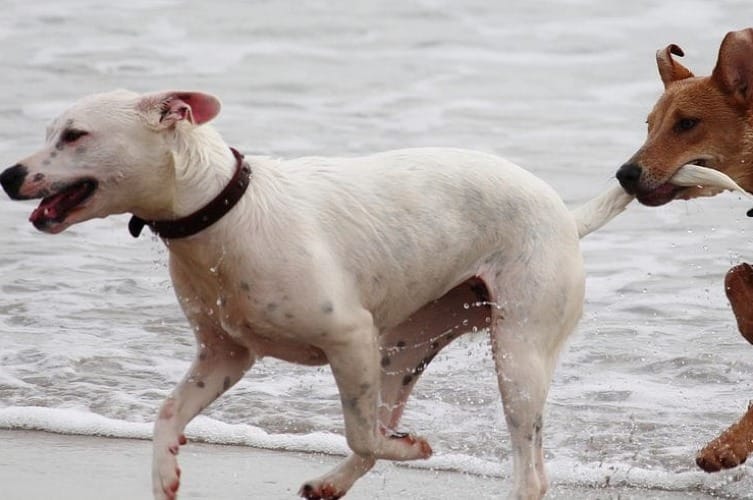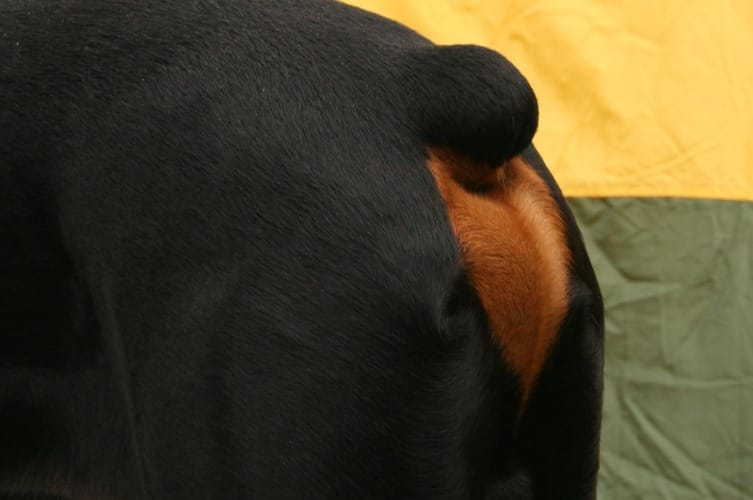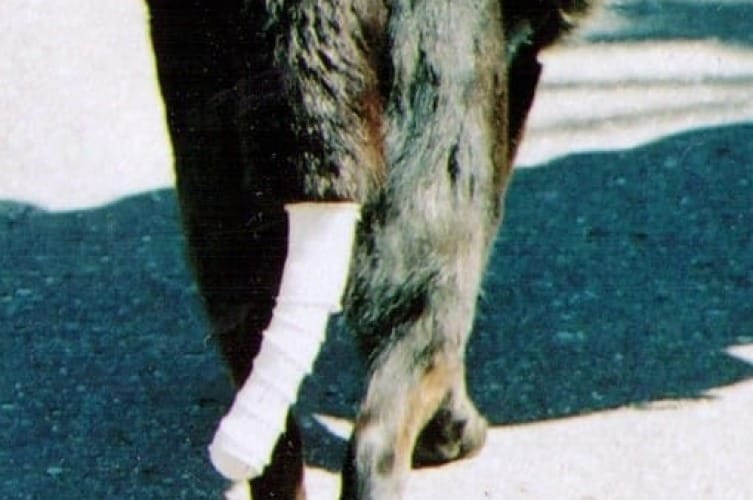Dogs are known for their wagging tails, which are often seen as a sign of happiness and excitement. However, in some cases, dogs may have their tails cut off. This practice, known as tail docking, has been a subject of controversy and debate for many years.

There are various reasons why dogs may have their tails cut off. One of the most common reasons is for cosmetic purposes, as some dog breeds are traditionally docked to conform to breed standards. Additionally, working dogs such as hunting dogs and herding dogs may have their tails docked to prevent injuries while on the job. However, tail docking is also done for non-medical reasons, such as to prevent destructive behavior or to comply with breed-specific legislation.
Despite the reasons behind tail docking, the practice remains controversial. Some argue that it is a painful and unnecessary procedure that can cause physical and psychological harm to dogs. Others argue that it is a necessary procedure to prevent injuries and maintain breed standards. As the debate continues, it is important to consider the welfare of dogs and weigh the benefits and risks of tail docking.
Historical Context of Tail Docking
Tail docking is a practice that has been around for centuries and has been performed on various breeds of dogs. The practice involves the removal of a portion of the dog's tail for various reasons. In this section, we will explore the historical context of tail docking, including its origins and evolution, as well as the historical functions of the practice.
Origins and Evolution of the Practice
The origins of tail docking are unclear, but it is believed to have started with hunting dogs. It is thought that hunters would dock their dogs' tails to prevent injury while hunting in dense vegetation or to prevent their tails from being caught in traps. Over time, the practice of tail docking spread to other breeds of dogs, including working dogs.
The evolution of tail docking has been influenced by various factors, including changes in dog breeding practices and cultural beliefs. In some cultures, tail docking is seen as a way to enhance the appearance of certain breeds of dogs, while in others, it is seen as a way to prevent injury or improve the dog's working ability.
Historical Functions of Tail Docking
Tail docking has served various functions throughout history. In addition to preventing injury while hunting, tail docking was also believed to prevent the spread of disease. It was thought that long tails could collect dirt and debris, which could lead to infection.
Tail docking has also been used to indicate the working ability of certain breeds of dogs. For example, working dogs such as sheepdogs and cattle dogs were often docked to prevent their tails from being stepped on or caught in machinery while herding.

In conclusion, tail docking has been a part of dog breeding and ownership for centuries. Its origins and evolution are complex, and the practice has served various functions throughout history. While opinions on tail docking vary, it remains a controversial topic in the world of dog breeding and ownership.
Understanding Tail Docking
Definition and Process
Tail docking is the surgical procedure of removing a portion of a dog's tail. The procedure can be done when the puppy is just a few days old or when the dog is older. The process involves cutting off the tail with surgical scissors or a scalpel and then sealing the wound with a cauterizing tool or sutures.
Tail docking is often done for aesthetic reasons, to conform to breed standards, or to prevent tail injuries. However, the procedure is controversial and is banned in some countries.
Breed-Specific Reasons for Docking
Tail docking is more common in certain breeds than others. Some breeds, such as the Doberman Pinscher and the Boxer, have docked tails as part of their breed standard. The reason for docking in these breeds is to give the dog a more streamlined appearance and to prevent tail injuries, which can be common in working dogs.
Other breeds, such as the Cocker Spaniel and the Schnauzer, may have their tails docked for aesthetic reasons or to conform to breed standards.
It is important to note that tail docking can have negative effects on a dog's health and well-being. The tail is an important part of a dog's communication system, and removing it can hinder their ability to communicate with other dogs and humans. Additionally, the procedure can cause pain and discomfort for the dog, and there is a risk of infection and other complications.
Overall, while tail docking may have some benefits for certain breeds and situations, it is important to carefully consider the potential risks and negative effects before deciding to have the procedure done.

Medical and Behavioral Aspects
Dogs can have their tails cut off for various reasons, including medical and behavioral aspects. In this section, we will explore the implications of tail docking on a dog's health and behavior.
Prevention of Injuries and Infections
Tail docking is sometimes performed as a preventive measure to avoid injuries and infections that may occur if a dog's tail is left intact. For instance, dogs with long tails are more prone to injuries when running through dense vegetation or playing with other dogs. The tail can get caught in branches or objects, leading to cuts, bruises, and even fractures. Moreover, dogs with long tails are more likely to develop infections, especially if they have a habit of wagging their tail vigorously, which can cause wounds to open up and become infected.
Tail docking, when performed correctly, can help prevent these injuries and infections. However, it is important to note that tail docking is not always necessary, and in some cases, it may even cause more harm than good.
Impact on Canine Communication and Behavior
Dogs use their tails to communicate a wide range of emotions, including happiness, fear, aggression, and excitement. By wagging their tail, a dog can show that they are happy and friendly, while a stiff and raised tail may indicate aggression or fear.
Tail docking can significantly impact a dog's ability to communicate with other dogs and humans. Dogs with docked tails may have difficulty expressing their emotions, which can lead to misunderstandings and even aggressive behavior. Additionally, tail docking can affect a dog's balance and movement, which can cause discomfort and even pain.
In conclusion, while tail docking may be necessary in some cases, it is important to consider the potential impact on a dog's health and behavior. If you are considering tail docking for your dog, it is important to consult with a veterinarian and weigh the pros and cons carefully.
Controversies and Legal Perspectives

Ethical Considerations
The practice of tail docking in dogs has been a subject of controversy for many years due to ethical considerations. Animal welfare activists argue that the procedure is cruel and unnecessary, causing pain and distress to the animal. They claim that dogs use their tails for communication, balance, and to express emotions, and that docking can interfere with these natural behaviors.
On the other hand, some breeders and owners argue that tail docking is necessary for certain breeds, such as working dogs, to prevent injuries and improve hygiene. They also claim that the procedure is painless if done at an early age and under proper anesthesia.
Global Legislation and Bans
Tail docking is illegal or banned in many countries around the world, including Australia, Canada, and the United Kingdom. In the United States, there is no federal law banning tail docking, but some states have their own legislation. For example, in California, tail docking is illegal unless it is performed by a licensed veterinarian for therapeutic purposes.
The reasons for these bans and legislation vary, but they are often based on animal welfare concerns. Some argue that tail docking is a cosmetic procedure that serves no medical purpose and is therefore unnecessary and cruel. Others believe that it is a form of animal mutilation that should be prohibited by law.
In conclusion, the controversy surrounding tail docking in dogs is complex and multifaceted. While some argue that it is necessary for certain breeds, others believe that it is a cruel and unnecessary practice that should be banned. As global legislation continues to evolve, it is important to consider the ethical implications of tail docking and to prioritize the welfare of our canine companions.
Veterinary Insights

Health Risks and Complications
Tail docking is a surgical procedure that involves removing a portion of a dog's tail. While the practice is still legal in some countries, it has become increasingly controversial due to the potential health risks and complications associated with the procedure.
According to the American Veterinary Medical Association (AVMA), tail docking can cause pain and discomfort for the dog. Additionally, the procedure can result in complications such as bleeding, infection, and the need for stitches. In some cases, dogs may even die as a result of the surgery or its complications.
Furthermore, research has shown that tail docking can have long-term effects on a dog's behavior and overall health. For example, dogs with docked tails may be more prone to certain types of injuries, such as spinal cord injuries. They may also have difficulty communicating with other dogs due to the loss of their primary means of nonverbal communication.
Professional Stance on Tail Docking
The AVMA and many other professional veterinary organizations have taken a clear stance against tail docking. These organizations argue that the procedure is unnecessary and can cause harm to the dog.
In fact, the AVMA recommends that veterinarians do not perform tail docking unless it is medically necessary. If the procedure must be performed, the AVMA recommends that it be done under anesthesia and with appropriate pain management.
Despite the professional stance against tail docking, the practice remains legal in some countries and is still performed by some breeders and owners. However, it is important for dog owners to understand the potential health risks and complications associated with the procedure before making a decision.

Aesthetic and Cultural Significance
Tail docking, the practice of removing a portion of a dog's tail, has been a controversial topic for many years. While some people argue that it is necessary for health reasons, others believe it is purely cosmetic. In this section, we will explore the aesthetic and cultural significance of tail docking.
Role in Dog Shows and Breed Aesthetics
Tail docking has been a long-standing tradition in many breeds of dogs. Breeders and owners often dock tails to conform to breed standards set by organizations such as the American Kennel Club. For example, Rottweilers, Boxers, Schnauzers, Poodles, and Spaniels are all breeds that commonly have their tails docked. In these breeds, the tail is seen as detracting from the overall appearance of the dog and is therefore removed.
In addition to conforming to breed standards, tail docking is also believed to serve a practical purpose for working dogs. For example, Doberman Pinschers and German Shorthaired Pointers were historically used for hunting and tail docking was believed to prevent injury to the tail while the dog was working in the field.
Perceptions of Tail Docking in Society
Despite its long-standing tradition in many breeds, tail docking has become increasingly controversial in recent years. Many people believe that it is a cruel and unnecessary practice that causes pain and discomfort to the dog. In some countries, tail docking has even been banned.
The perception of tail docking in society has shifted to view it as a cosmetic procedure rather than a necessary one. The American Veterinary Medical Association, for example, opposes tail docking for cosmetic reasons and believes that it should only be done for medical reasons.
In conclusion, while tail docking has been a long-standing tradition in many breeds of dogs, its aesthetic and cultural significance is increasingly being questioned. As society's views on animal welfare continue to evolve, it remains to be seen whether tail docking will continue to be a common practice in the future.

Alternatives and Preventative Measures
Non-Surgical Options
Tail docking has been a common practice for many years, but it is now considered unnecessary and inhumane in most countries. There are several non-surgical options that pet parents can explore to prevent tail injuries and damage. One such option is to train dogs to avoid wagging their tails in confined spaces or around fragile objects. This can be achieved through positive reinforcement training and by providing dogs with enough space to move around freely.
Another non-surgical option is to use tail guards, which are protective coverings that fit over the tail to prevent injuries and damage. These guards are made from soft, flexible materials that won't irritate the dog's skin or cause discomfort. They are especially useful for dogs that participate in high-intensity activities or sports.
Advancements in Veterinary Care
Advancements in veterinary care have made it possible to treat tail injuries and damage without resorting to tail docking. For example, if a dog has a broken tail, a veterinarian can often splint or brace the tail to help it heal. In some cases, surgery may be necessary to repair the tail, but this is usually a last resort.
Pet insurance can also help pet parents cover the cost of veterinary care for tail injuries and damage. By investing in pet insurance, pet parents can ensure that their furry friends receive the best possible care without breaking the bank.
In conclusion, there are several alternatives and preventative measures that pet parents can explore to avoid tail injuries and damage in their dogs. By using non-surgical options such as training and tail guards, and by taking advantage of advancements in veterinary care, pet parents can keep their furry friends safe and healthy without resorting to tail docking.
Frequently Asked Questions
- What are the reasons behind tail docking in certain dog breeds?
- Tail docking is a practice that has been used for centuries for various reasons, including working dogs to prevent injury or infection to their tails, as well as for aesthetic purposes in certain breeds. Some breed standards require a docked tail for a dog to be considered a purebred.
- Is tail docking considered harmful or beneficial for dogs?
- The practice of tail docking is a controversial topic, with arguments on both sides. Some argue that it can prevent injury or infection to the tail, while others argue that it is unnecessary and can cause pain and distress to the dog. In many countries, tail docking is considered illegal unless it is done for medical reasons.
- Which dog breeds are commonly associated with the practice of tail docking?
- Breeds that are commonly associated with tail docking include Boxers, Doberman Pinschers, Schnauzers, and some hunting breeds such as Cocker Spaniels and Pointers. However, the practice is becoming less common as more breed standards are changing to allow for natural tails.
- Are there any legal or ethical considerations regarding tail docking in dogs?
- In many countries, tail docking is considered illegal unless it is done for medical reasons. Some animal welfare organizations consider tail docking to be unnecessary and cruel, while others argue that it is a necessary practice for certain working breeds.
- What are the potential health impacts of tail docking on a dog's well-being?
- Tail docking can cause pain and discomfort to the dog, as well as potential complications such as infection or nerve damage. Additionally, the tail is an important part of a dog's body language and communication, and removing it can affect their ability to communicate with other dogs.
- How does tail docking affect a dog's communication and behavior?
- The tail is an important part of a dog's body language and communication, and removing it can affect their ability to communicate with other dogs. Dogs use their tails to convey emotions such as happiness, fear, and aggression, and removing the tail can make it more difficult for them to express themselves and understand other dogs.




